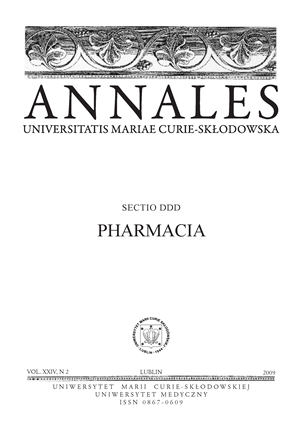Expression of pro-apoptotic signalling molecules mRNAin lung cancer
DOI:
https://doi.org/10.2478/v10080-008-0190-yAbstract
The main features of cancer cells that distinguish them from normal cells are uncontrolled synthesis of molecules that stimulate growth and insensitivity to apoptotic stimuli such as radiation or chemotherapy. Smac/DIABLO (second mitochondria-derived activator of caspases/direct IAP binding protein with low pI) is a pro-apoptogenic mitochondrial protein that is released from mitochondria similarly to cytochrom c, AIF, Omi/HtrA2. Smac/DIABLO inhibits proteases and in that way caspases may avoid inactivation, which allows progress of apoptosis pathway. Better understanding of a signal apoptotic transduction in cancer cells gives hope to obtain drugs that could be used in cancer therapy. The aim of the study was to investigate the level of proapoptotic signals coming from pre-mitochondrial and mitochondrial sources in lung cancer depending on selected clinico-pathological parameters. The p53, Smac/DIABLO and Omi/Htr2 mRNA relative expression was evaluated in lung cancer specimens taken from 39 male patients. The study revealed lack of significant differences in p53, Smac/DIALO and Omi/Htr2 mRNA expression according to the histological type and grade of cancer differentiation as well as age categories. It could be concluded that the level of apoptotic signalling represented by p53, Smac/DIABLO and Omi/Htr2 in the tested specimens is comparable despite the tested parameters.
References
1. De Boever S. et al.: Identification and validation of housekeeping genes as internal control for gene expression in an intravenous LPS inflammation model in chickens.Vet Immunol Immunopathol., 122, 312, 2008.
2. Fulda S. et al.: Smac agonists sensitize for Apo2L/TRAIL- or anticancer drug-induced apoptosis and induce regression of malignant glioma in vivo. Nat Med., 8, 808, 2002.
3. Gao Z. et al.: A dimeric Smac/diablo peptide directly relieves caspase-3 inhibition by XIAP. Dynamic and cooperative regulation of XIAP by Smac/Diablo. J. Biol. Chem., 282, 30718, 2007.
4. Hollstein M. et al.: p53 mutations in human cancers. Science, 253, 49, 1991.
5. Kashkar H. et al.: XIAP targeting sensitizes Hodgkin lymphoma cells for cytolytic T-cell attack. Blood, 108, 3434, 2006.
6. Krepela E. et al.: Expression of apoptosome pathway-related transcripts in non-small cel lung cancer. J. Cancer Res. Clin. Oncol., 132, 57, 2006.
7. Sekimura A. et al.: Expression of Smac/DIABLO is a novel prognostic marker in lung cancer. Oncol. Rep., 11, 797, 2004.
8. Srivastava R. K. et al.: Bcl-2 and Bcl-X(L) block thapsigargin-induced nitric oxide generation, c-Jun NH(2)-terminal kinase activity, and apoptosis. Mol. Cell Biol., 19, 5659, 1999.
9. van Loo G. et al.: The role of mitochondrial factors in apoptosis: a Russian roulette with more than one bullet. Cell Death Differ., 9, 1031, 2002.
10. Verhagen A. M. et al.: Identification of DIABLO, a mammalian protein that promotes apoptosis by binding to and antagonizing IAP proteins. Cell, 102, 43, 2000.
11. Vince J. E. et al.: IAP antagonists target cIAP1 to induce TNFalpha-dependent apoptosis. Cell, 131, 682, 2007.
12. Vousden K. H., L u X.: Live or let die: the cell’s response to p53. Nat. Rev. Cancer, 2, 594, 2002.
13. Wang L., Du F., Wang X.: TNF-alpha induces two distinct caspase-8 activation pathways. Cell, 133, 693, 2008.
14. Yang X. et al.: Akt-mediated cisplatin resistance in ovarian cancer: modulation of p53 action on caspase-dependent mitochondrial death pathway. Cancer Res., 66, 3126, 2006.
15. Yoo N. J. et al.: Immunohistochemical analysis of Smac/DIABLO expression in human carcinomas and sarcomas. APMIS, 111, 382, 2003.
16. Zhao J. et al.: Transfection of Smac sensitizes tumor cells to etoposide-induced apoptosis and eradicates established human hepatoma in vivo. Cancer Gene Ther., 13, 420, 2006.
Downloads
Published
Issue
Section
License
Copyright (c) 2009 Authors

This work is licensed under a Creative Commons Attribution-NonCommercial-NoDerivatives 3.0 Unported License.


